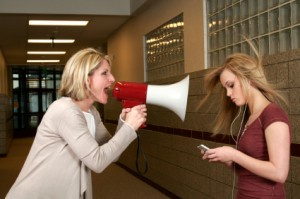communication skills
Leaders Are Listeners: 10 Easy Steps to Effective Listening Skills
When you think of people you like to hang out with, chances are, one of their qualities is that they are good listeners. In the age of technology, listening is becoming a lost art. It’s easy to let the pseudo-communication of social media and texting replace real conversations.
But, leaders are listeners.
When you listen, you learn. And it shows people that what they have to say is important. Think about it. The people who listen to us are the ones we move toward. When we are listened to, it validates us and helps us open our minds.
To enhance the human connection on your campus, show some leadership and follow these strategies to better listening.
1. Listen, listen, listen.
Just like you’d get yourself in the mental mode to play your favorite sport, take a test, or drive a car, it’s important that we mentally prepare ourselves to listen. Listening takes discipline – similar to training for your sport, studying for a test or learning to drive! So practice with intention.
2. Get rid of distractions.
 Put away your smartphone. Period.
Put away your smartphone. Period.
It’s a drag when someone feels like anything and everything else is more important than the person standing in front of them.
If you’re in a crowded, noisy place (such as a party or game) and it’s an important conversation, ask to move somewhere that’s quieter.
3. Don’t judge too early.
It’s easy to jump to conclusions before we have heard the whole story. Listening is also about waiting and patience (remember how it’s a discipline?) Don’t feel bad if you’re not in complete agreement with the other person. Leaders acknowledge and respect others’ views.
4. Ask questions.
When you ask questions, you convey genuine interest. It makes people feel good. Meaningful questions help a conversation take on more depth, and you create a rapport and trust with the other person. And – leadership is about gaining the trust of others.
5. Focus on key ideas – and what isn’t said out loud.
Instead of drifting off in boredom, listen for and extract the central idea.
This means to pay close attention to what is being said beneath the words. Focus on what’s NOT being said, too. Interpreting another person’s tone and feelings takes some observation and insight.
6. Don’t forget about body language.
Great listening skills go beyond what your ears are doing. Face the other person, maintain eye contact, and nod your head to demonstrate you’re fully committed to the conversation.
7. Suspend your own agenda.
Often, instead of listening to what’s actually being said to us, we mentally formulate our response. It’s hard, but focus on the speaker’s words and forget about your stuff. Sometimes, people don’t want advice. They just want a listening ear.
8. Empathize.
Consider the speaker’s point of view as if their concepts were your own. Empathy places you in the other person’s shoes and helps you gain a sense of their feelings and experiences. It’s not easy, but you’re practicing!
9. Acknowledge their point of view is valid.
People are different. We often don’t agree with others, but great listening includes acknowledgement. Their point of view is just as important and worthy as our own. Remember, everyone wants to feel important!
10. Paraphrase.
Repeat back the speaker is saying to make sure you’ve understood. This also demonstrates attentive listening. For example,
“So you’re telling me that you think my employee evaluation process is unfair?”
“Oh… so you hate the music we play at our dances?”
That’s it! Practice these listening techniques throughout your week and let me know how it goes.
Or, if I’ve missed one, please let me know in the comments section below. Thanks!
8 Reasons Why You Should Eat Dinner With Your Family
Can eating dinner together help teens and their parents stay better connected?
A report by the US Health Resources and Services Administration found significant differences between teens who eat dinner with their parents at least five times a week and those who do not. Similarly, significant differences were found for teens who reported feeling “close” to their mother and/or father and those who did not.
• Smoking
Among teenagers aged 15 to 16, 42 % of teenagers who do not feel close to their mother and/or father smoke, compared with 26 % of teenagers who do feel close to at least one parent. In this same age group, over 34 % of teenagers who do not regularly eat supper with their parents smoked, in contrast to just 25 % of teenagers who do eat supper regularly with their parents.
• Drinking
The prevalence of drinking is nearly twice as high among 15 to 16 year olds who do not feel close to a parent and among those who do not eat supper with a parent, compared with those who do.
• Drug Use
About 50 % of 15 to 16 year olds who aren’t close to their parents have used marijuana, compared with just 24 % of those who are close to their parents.
• Violence
Less than 30 % of teenagers aged 15 to 16 who eat supper with their parents have been in a serious fight, compared with more than 40 percent of those who do not eat supper with their parents.
• Sexual Activity
Over 50 % of teenagers who do not eat supper with their parents have had sex by age 15 to 16. By contrast, only 32 % of teenagers who do eat supper with their parents have had sex.
• Suicidal Thoughts
Teenagers aged 15 to 16 who do not feel close to their parents are about three times as likely to think about suicide as teenagers who are close to their parents.
• Suicide Attempts
Teenagers aged 15 to 16 who don’t eat supper with their parents regularly are twice as likely to have attempted suicide.
• Educational Achievement
Teenagers of all ages who eat with their parents, or feel close to their parents, perform very well at school. In general, they are more likely to go to university and less likely to have been ever suspended from school.
You can read the full U.S. Department of Health and Human Services, Health Resources and Services Administration. U.S. Teens in Our World report: Here
Do you think having dinner together as a family can help teens avoid risky behavior and better connect with their parents? Tell me your thoughts!
Public Speaking 101
Your purpose is to make your audience see what you saw, hear what you heard, feel what you felt. Relevant detail, couched in concrete, colorful language, is the best way to recreate the incident as it happened and to picture it for the audience – Dale Carnegie
If facing a large audience gives you shivers, and the thought of public speaking gives you pangs of nervousness, make sure to follow these basic guidelines before you prepare for your next public speech or presentation.
Make the introduction gripping, and the content clear and concise
The content of your speech is the backbone of your success. Remember that first impressions are the last ones too, and aim to capture the attention of your listeners with your first expression. Starting with an inspirational quote, or a relevant short story, may work well to grip an audience. Ryan McLean highlights the importance of a captivating beginning by saying, “Your introduction needs to establish with the audience why it is important to them and why they should be listening to the speech.”
That being said, the quality of the main body is equally essential to ensure a successful outcome. The success of your presentation will be judged not by the knowledge you send out, but by what the listeners grasp from your words. Be understandable and assertive on your viewpoints; make sure you speak slowly, clearly, and thoughtfully. Keep the content to the point, avoid beating about the bush, and keep in mind the difference between a lecture and a speech. When determining the length of your content, take a hint from Dorothy Sarnoff’s advice, “Make sure you have finished speaking before your audience has finished listening.”
Confidence, composure, and poise
Undoubtedly, the most feared words of public speaking. You may be trying your best to avoid eye contact or imagining there is no one in the room, but as dreaded as it is, eye contact and speaking with confidence is extremely vital for an exceptional public act. It is absolutely vital for a public speaker to know the difference between ‘public reading’ and ‘public speaking’. Your audience is not there to watch your head hanging down as you read from a piece of paper. Make sure to be well-dressed, keep your hands out of your pocket, and stand tall and erect without moving a lot.
Public speaking is only 10% what you deliver and 90% how you deliver. Make sure you have researched well on your facts and figures, and confidently convey it to your listeners to make them believe in your potential and credibility. Keep it engaging and smooth by focusing your gaze on the audience as you speak and redirecting it to different listeners through the act.
Stay calm under unexpected problems
Broken multimedia, faulty projectors and whistling speakers are a common sight at conferences and corporate meetings. It is completely normal to experience technology hitches, unforeseen accidents, unnecessary interruptions, or simply going blank during your speech, or presentation. Stay calm under pressure, crack a joke, avoid being over apologetic, and most importantly never bury your face in your hands! Express your need for a pause to recollect your thoughts and resume once you are ready. Your tactful demeanor and quick recovery from a setback may leave your audience even more impressed.
Icebreakers: From a Bunch to a Team
Do you remember going to an event where you never left your seat or exited the event without getting to know the name of the person sitting in front of you? If yes, then the event planners may have not paid enough heed to the icebreakers!
An effective and engaging way to start a public speaking event, training sessions, and team-building activities; icebreakers are the ‘hook’ to grip an audience. Not only do they push the event off to a great start, but icebreakers also prove instrumental in getting the audience to know each other, to get acquainted with the objectives of the event, to keep them captivated throughout the proceedings and encourage their participation to the purpose of the event, which contributes to a successful outcome.
When should icebreakers be used?
Just as the name suggests, they should be used whenever you need to “break the ice” within the audience at an event or a meeting. An icebreaker is often used when people from different professional or cultural backgrounds, who may possibly not know each other at all, meet for a common purpose. The icebreaking activities should aim to quickly bond the people towards the event goal, uplift the comfort levels in a newly formed team, throw hints about the upcoming topics of the session, and get the facilitator, or the speaker, and the participants to know each other better.
What to use and where?
An icebreaker activity designed to kick start a high school motivational talk, would be certainly different from one targeted at a professional audience. Make sure to design the activity that is appropriate to the target audience and pertinent to the objective of the meeting. While a Human Bingo may offer a mighty kick off to a student’s networking event; beginning with a short quiz or by stating some relevant news or facts may be more suitable for professional environments. Some popular and effective icebreakers include:
A ‘Raise Your Hand’ round:
This versatile activity works well for any event, corporate or casual, and stimulates the energy level as the audience raises their hands in response to different questions or audience polls.
The Hook:
Start a story but don’t finish it! As your audience gets captivated by the events, stop by saying, “I’ll get back to this towards the end.” This will keep them engaged till the end of the session.
Two Truths, One Lie:
An interactive activity for introduction, this generally works well with smaller groups but can also be effectively employed by selecting random participants to discreetly tell three facts about themselves, of which two should be true and one a lie. The audience keeps guessing the lie in a poll until the participant reveals it.
Brainstorm and Problem Solving:
Tried and tested, these universal icebreakers can either be used to start an event or in the middle, to boost the energy level and creativity of the participants. Get the group organized into smaller teams and assign a simple problem scenario for them to brainstorm and work out in a short time. Each group should then be asked to present their solutions to the other teams. This activity can be used to potentially go through multiple topics in a short span of time.
When designing your icebreaker, it is important to remember that while a good icebreaker can make a successful event, a poor one can break the entire tempo. While activities may always come in handy to mobilize the audience and keep them keyed up, starting off with a joke or an interesting quote may also work as an effective icebreaker to give your audience a promising impression of the event.
Excellent Interpersonal Skills
You may have the best qualifications and the most comprehensive work experience on your CV, but if you are unable to get along with your colleagues or fellow students, you may not be able to go far! How your coworkers see you heavily depends on your interpersonal communication skills, and can have a long-term impact on your career possibilities as well as your routine life. Read on to find out some effective tips to strengthen your social skills and make better connections with your team mates.
Be a sensible and effective speaker
To have your opinions valued, it is important that you weigh your words and thoughts before voicing them out. Intelligence and maturity are the secret ingredients to achieving exceptional communication skills. Avoid revealing the first thought that crosses your mind, without contemplating, to avoid misunderstandings and misperceptions with your peers.
An effective verbal communication is all about clarity. Slow down and speak more considerately, avoid impulsive responses to questions, and pause for a while to digest the conversation before offering your opinions. Stay calm and focused, speak politely and just follow basic professional ethics, and all should be well!
Your thoughtfulness and sensibility can take you a long way in being taken seriously, and so can a splash of vigilant humor. You may have already noticed that the funny guy in your office, or classroom, is also quite popular. As long as you keep off inappropriate humorous remarks, or offensive jokes, you will be able to ease out communication barriers with a timid peer or a grumpy manager!
Be a good speaker, but a better listener
It may be a lost virtue, but active listening is vital for great interpersonal skills. In addition to being an audience to your words, your coworkers would want to be heard and understood too. Make sure you recognize others’ perspective and demonstrate a basic understanding of their viewpoints. Try repeating what the speaker has said to express your attention and feel more connected.
Effective verbal communication has to be two-sided. Be prepared to listen to your colleagues with an open mind and concentration, and avoid emerging as distracted, judgmental, and disrespectful towards their point of views. To be approachable and favored, treat other speakers with the same dignity and importance as you would like for your own words.
Positive attitude, happy face, and considerate nature
Non-verbal communication provides the foundation for efficient verbal communication. Maintain a confident body language, be courteous and supportive, and most importantly, don’t be a whiner! Your constant smile can become your identity at your workspace, and your considerate nature can make you the most favorite employee among your colleagues. Get into a habit of writing positive appreciation notes to your coworkers; celebrate even the pettiest of achievements; remember their birthdays and important evens; always wear a cheerful outlook, and never hold back praises and thank-you. By representing a caring and courteous demeanor, you will have the same feelings reciprocated towards you.
Stay aware of your surroundings and focus on self-management
How effective your interpersonal skills are, basically depends on how well you manage your anger, frustration, mood swings and other emotions. Focus on self-management and maintain a calm and composed outlook at work and school. Be compassionate to a struggling coworker, avoid laughing in tense situations, and most importantly, keep a tap on your own emotions to be empathetic to others.
Be assertive yet open to constructive feedback
While it is important to always be polite and respectful, it is also essential that you demonstrate a certain level of assertiveness to get your point across and well-taken in a competitive environment. However, it is vital that you don’t come off as being rude or offensive. It is completely normal to defend your ideas with confidence, but remember to keep aggression at bay. Keep you volume and tone under control, choose appropriate words, and be tactful enough to emerge out of the situation respectably.
At times, your opinions may meet criticism and opposition, but there’s a reason why they are called opinions and not facts! Avoid taking criticism and negative feedback personally and remain flexible around your set course of action. There may be other better ideas than yours, accept them with an open mind to maintain a professional and persevering character.








